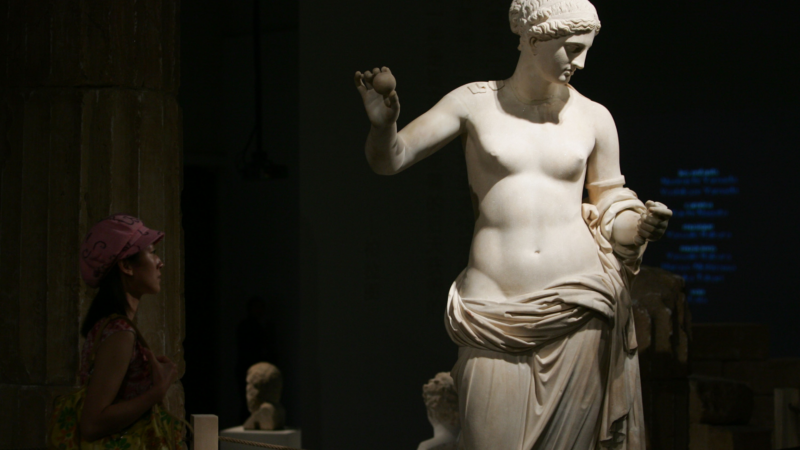Ancient Greek and Roman statues often smelled like roses, a new study says
Researchers have known for many years that there was more to ancient Greek and Roman statues than the plain white marble you typically see in museums.
A few years ago, museum visitors in New York City finally got the opportunity to see how the statues would actually have appeared when they were created: painted in vibrant colors.
Now, a researcher says there’s another aspect to these statues to consider: how they smelled.
Cecilie Brøns, a senior researcher and curator of the Glyptoteket museum’s collection of ancient Greek and Roman art in Copenhagen, Denmark, says ancient texts provide evidence that statues were often scented with perfumes, oils and waxes.
Her study, “The Scent of Ancient Greco-Roman Sculpture,” was published in the Oxford Journal of Archaeology this month.
Ancient Greek and Roman sculptures were not just experienced visually, Brøns writes in her article. “Such scents could function as a way of creating a sensorial experience and even facilitating interaction between the image and the observer, without the use of touch.”
Previous research has shown that these statues were painted and sometimes decorated with jewelry and textiles, she writes. But the adding of scents “would have made the experience of them not only a visual but also an olfactory one.”
A variety of flowers and herbs were used to make the perfumes, but evidence points to rose perfume being the most widely used type, Brøns said in an email to NPR.
Some records of this scenting come from ancient bookkeeping. About 2,800 stones with inscriptions have been found on the Greek island of Delos, some of which are inventories from temples on the island.
“These inscriptions are extremely interesting and have some clear evidence for the use of perfumes and scented oils for the cult images in the temple on the island,” Brøns said in her email. (Cult images refer to objects that are worshipped for representing gods.)
Brøns also referenced numerous ancient writers as evidence of the practice. For example, the Greek physician Dioscorides provided a recipe for myron rhodinon, which translates to “perfume made from roses.” Pausanias, a Greek geographer, writes that a “statue of Zeus at Olympia was treated with olive oil,” according to Brøns.
Brøns is fond of a quote she attributes to the Roman philosopher Cicero, about the treatment of a statue of Artemis. People “anointed her with precious unguents” and “crowned her with chaplets and flowers,” Cicero wrote.
The Cicero quote “clearly shows that perfumes and flower wreaths were used for the cult images,” Brøns said.
Physical evidence of scents on statues is hard to come by, as the oils and waxes degrade over time. One exception is a statue of the Ptolemaic Queen Berenice II from the third century B.C. Brøns said previous research did not detect a scent, but did detect evidence of beeswax spread on the statue.
There were religious reasons for the practice

The motivation for scenting and adorning statues was primarily religious.
“It was primarily a ritual act, as a sort of veneration for the cult images,” said Brøns, though she added that some nonreligious statues may have been scented as well.
Sculptures were usually painted, and often were decorated with jewelry and flower wreaths. “The aim of this was to make them seem ‘alive’ (expressed by the Greek term mimesis),” Brøns wrote in her email.
In her article, Brøns notes that some oils and waxes were also used to protect and preserve the statues and their paint.
Verity Platt, a professor at Cornell University’s Department of Classics who specializes in Greek and Roman art history and was not involved in the study, said scenting and adorning with flowers were also parts of Greek social life.
For instance, according to Platt, Greek men would scent their bodies before they gathered to drink at the symposium, a social gathering where they participate in rituals related to Dionysus, the Greek god of wine and theater.
There were also animal sacrifices that involved smell. “Within Greek myth there’s this idea that the smell goes up to the gods on Mount Olympus … and it delights them. They love the smell of sacrifice. So pleasing the gods with smells that are offerings is part of a bigger realm of the sensory landscape of Greek religion,” Platt told NPR.
“There is religion embedded in everything in the ancient world,” she added. “There isn’t really a concept of the secular.”
Platt said that among experts in classical studies, the idea that statues were scented is already well-established. But given the attention the study has received, it’s clear many people hadn’t heard about the practice before.
“Clearly it strikes a chord,” she said, noting it follows recent interest in the notion that statues were painted in bright colors. “It’s exciting to think about the ancient world as not just polychrome but also multi-sensory in all kinds of ways.”
Alabama Power seeks to delay rate hike for new gas plant amid outcry
The state’s largest utility has proposed delaying the rate increase from its purchase of a $622 million natural gas plant until 2028.
Former U.S. Sen. Doug Jones announces run for Alabama governor
Jones announced his campaign Monday afternoon, hours after filing campaign paperwork with the Secretary of State's Office. His gubernatorial bid could set up a rematch with U.S. Sen. Tommy Tuberville, the Republican who defeated Jones in 2020 and is now running for governor.
Scorching Saturdays: The rising heat threat inside football stadiums
Excessive heat and more frequent medical incidents in Southern college football stadiums could be a warning sign for universities across the country.
The Gulf States Newsroom is hiring an Audio Editor
The Gulf States Newsroom is hiring an Audio Editor to join our award-winning team covering important regional stories across Mississippi, Alabama and Louisiana.
Judge orders new Alabama Senate map after ruling found racial gerrymandering
U.S. District Judge Anna Manasco, appointed by President Donald Trump during his first term, issued the ruling Monday putting a new court-selected map in place for the 2026 and 2030 elections.
Construction on Meta’s largest data center brings 600% crash spike, chaos to rural Louisiana
An investigation from the Gulf States Newsroom found that trucks contracted to work at the Meta facility are causing delays and dangerous roads in Holly Ridge.









